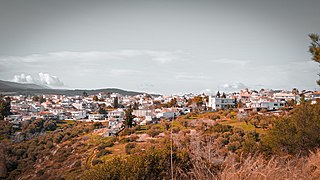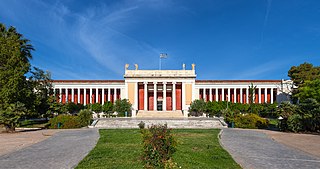Gallery
- A Hellenistic Greek encaustic painting on a marble tombstone depicting the portrait of a young man named Theodoros, dated 1st century BC during the period of Roman Greece
The Archaeological Museum of Thebes is a museum in Thebes, Greece dedicated to the Boeotia region.
The history of the museum began in 1894 when barracks on the site of the current museum where turned into exhibition rooms for archaeological finds from across Boeotia. In 1905 a new building was erected with funds from the Archaeological Society at Athens. The current building was built in 2007.
38°19′25″N23°19′4″E / 38.32361°N 23.31778°E

Thebes is a city in Boeotia, Central Greece, and is one of the oldest continuously inhabited cities in the world. It is the largest city in Boeotia and a major center for the area along with Livadeia and Tanagra.

Boeotia, sometimes Latinized as Boiotia or Beotia is one of the regional units of Greece. It is part of the region of Central Greece. Its capital is Livadeia, and its largest city is Thebes.

Plataea was an ancient Greek city-state situated in Boeotia near the frontier with Attica at the foot of Mt. Cithaeron, between the mountain and the river Asopus, which divided its territory from that of Thebes. Its inhabitants were known as the Plataeans.

Tanagra is a town and a municipality north of Athens in Boeotia, Greece. The seat of the municipality is the town Schimatari. It is not far from Thebes, and it was noted in antiquity for the figurines named after it. The Tanagra figurines were a mass-produced, mold-cast and fired type of Greek terracotta figurine produced from the later fourth century BC, primarily in Tanagra.

Lefktra is a village in the regional unit of Boeotia, Greece, and a part of the municipality of Thebes. Before 1915, its name was Parapoungia. Lefktra is located in the foothills of Mount Kithairon at 353 meters average elevation. The population of Lefktra is 779 people. Thebes is sixteen kilometers away and Athens 70 km away, via the old national road. There are bus lines from Thebes to Lefktra and vice versa daily, and from Athens to Lefktra at the weekends. Residents' main occupations are agriculture and stockbreeding. Livadostra and Koromili beaches are ten minutes away by car.

National Road 44 is a single carriageway road in central Greece. It connects Thebes with Karystos on southern Euboea, via Chalcis and Eretria. The total length of the GR-44 is nearly 160 km. The highway lies in the regional units of Boeotia and Euboea.

Orchomenus, the setting for many early Greek myths, is best known today as a rich archaeological site in Boeotia, Greece, that was inhabited from the Neolithic through the Hellenistic periods. It is often referred to as "Minyan Orchomenus", to distinguish it from a later city of the same name in Arcadia.

Gla, also called Glas (Γλας), was an important fortified site of the Mycenaean civilization, located in Boeotia, mainland Greece. Despite its impressive size, more than ten times larger than contemporary Athens or Tiryns, Gla is not mentioned in the Iliad.

The National Archaeological Museum in Athens houses some of the most important artifacts from a variety of archaeological locations around Greece from prehistory to late antiquity. It is considered one of the greatest museums in the world and contains the richest collection of Greek Antiquity artifacts worldwide. It is situated in the Exarcheia area in central Athens between Epirus Street, Bouboulinas Street and Tositsas Street while its entrance is on the Patission Street adjacent to the historical building of the Athens Polytechnic university.
Adamantios Sampson is a Greek archaeologist who served as an Inspector of Antiquities for the Greek Administration of Antiquity. Since 1999, he has been a professor in the University of the Aegean, Department of Mediterranean Studies, Rhodes
Oenoe or Oinoe was a deme of Athens, situated upon the confines of Boeotia and Attica, near Eleutherae, and upon the regular road to Plataea and Thebes. Hysiae and Oenoe are mentioned as the frontier demes of Attica in 507 BC, when they were both taken by the Boeotians. From this time Hysiae continued to be a Boeotian town; but Oenoe was recovered by the Athenians, and was fortified by them before the commencement of the Peloponnesian War. In 411 BC, the Boeotians again obtained possession of Oenoe; but it must have been recovered a second time by the Athenians, as it continues to be mentioned as an Attic demus down to the latest times.

The German Archaeological Institute at Athens is one of the 19 foreign archaeological institutes operating in Athens, Greece.

Ieronymos II is the Archbishop of Athens and All Greece and as such the primate of the Autocephalous Orthodox Church of Greece. He was elected on 7 February 2008.
Aulis was a Greek port town, located in ancient Boeotia in central Greece, at the Euripus Strait, opposite of the island of Euboea, at modern Mikro Vathy/Ag. Nikolaos. Livy states that Aulis was 3 miles (4.8 km) from Chalcis.
Schoenus or Schoinos was a city in ancient Boeotia, located east of Thebes. Schoenus is mentioned by Homer as part of Thersander's domain in the Catalogue of Ships in the Iliad. Schoenus is placed by Strabo upon a river of the same name in the territory of Thebes, upon the road to Anthedon, and at the distance of 50 stadia from Thebes. This river is probably the stream flowing into the lake of Hylica from the valley of Mouriki, and which near its mouth is covered with rushes. Nicander is clearly wrong, who makes the Schoenus flow into Lake Copais. Schoenus was the birthplace of the celebrated Atalanta, the daughter of Schoenus; and hence Statius gives to Schoenus the epithet of "Atalantaeus."
Victoria Sabetai is a member of the Research Centre for Antiquity at the Academy of Athens where she is principally involved with research for the Corpus Vasorum Antiquorum, a project aiming to publish ancient Greek pottery in museums and private collections.
Anthedon (Ἀνθηδών) was a town in Boeotia, Ancient Greece, located on the coast of the Gulf of Euboea, about 15 kilometres (9.3 mi) west of Chalcis, at the foot of Mount Messapius. It was member of the Amphictyonic League, and served as port for Thebes. In ancient times, it was believed to have had one of the mythical characters named Anthedon as its eponym.

Ptoion is a mountain chain in northeastern Boiotia. It stretches from Akraiphia by the former Lake Copais in the west to the Gulf of Euboea in the east, reaching up to 725 m in the west and 781 m (Petalás) in the east. The massif is particularly famed for the oracle of Apollo, which was located in the sanctuary of Apollo Ptoios at the western end of the range and was among the most important Greek oracles up to the time of the Persian Wars.
Teumessus or Teumessos was a town in ancient Boeotia, situated in the plain of Thebes, upon a low rocky hill of the same name. The name of this hill appears to have been also given to the range of mountains separating the plain of Thebes from the valley of the Asopus. Teumessus was upon the road from Thebes to Chalcis, at the distance of 100 stadia from the former. It is mentioned in one of the Homeric hymns with the epithet λεχεποίη or grassy, an epithet justified by the rich plain which surrounds the town. Teumessus is celebrated in the epic legends, especially on account of the Teumessian fox, which ravaged the territory of Thebes. The only building at Teumessus mentioned by Pausanias was a temple of Athena Telchinia, without any statue. Pausanias also mentions that Zeus hid Europa in Teumessus. The torrent Thermodon ran down Mount Hypatus on its way to Teumessus.
Eleon, or Heleon (Ἑλεὼν), was a town in ancient Boeotia, mentioned by Homer in the Catalogue of Ships in the Iliad in the same line with Hyle and Peteon. It is said by Strabo to have been one of the smaller places in the territory of Tanagra, and to have derived its name from its marshy situation.